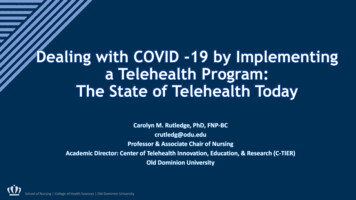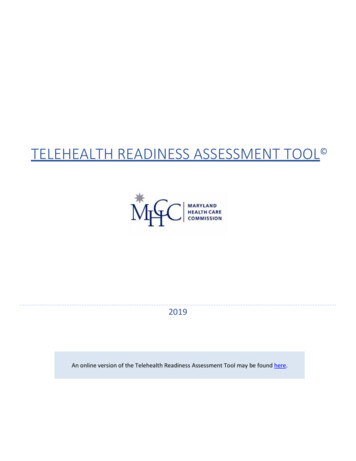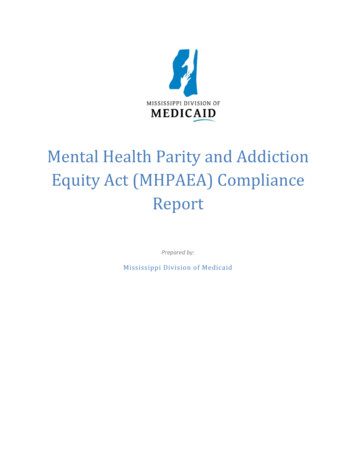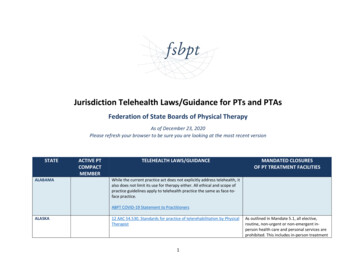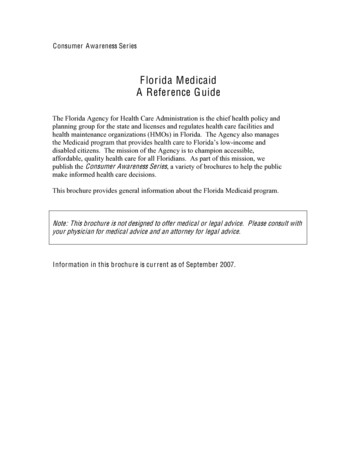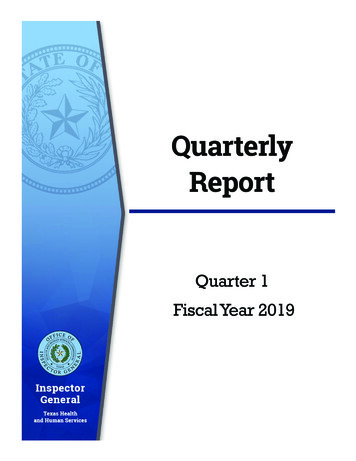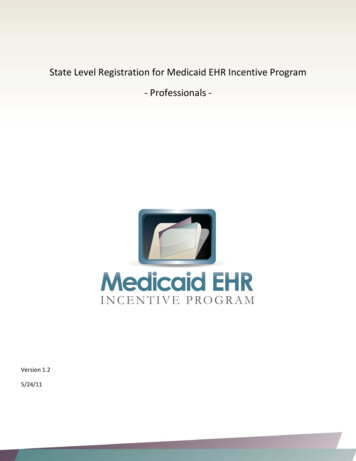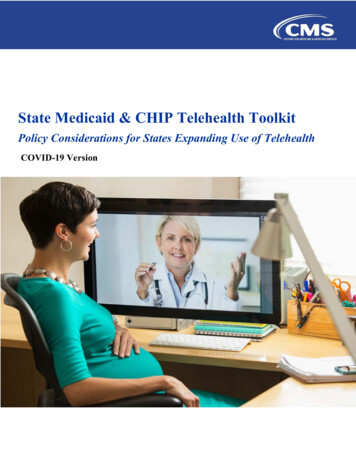
Transcription
State Medicaid & CHIP Telehealth ToolkitPolicy Considerations for States Expanding Use of TelehealthCOVID-19 Version
1
Table of ContentsIntent of Toolkit . 3A Note on Medicare. 4Quick Facts . 4State Considerations . 6Pediatric Considerations . 7State Checklist . 9CMS Contact Information . 16Appendix A: Frequently Asked Questions . 17Benefit Flexibilities . 17Financing Flexibilities . 19Workforce Flexibilities . 20Managed Care Flexibilities . 21Health Information Exchange Flexibilities. 22T-MSIS Coding Guidance . 22Appendix B: Resources . 232
Intent of ToolkitThe Centers for Medicare & Medicaid Services (CMS) is working hard to make sure we help ourbeneficiaries and the people who are working on the front lines to care for patients during thispandemic. We have taken numerous steps to respond to the pandemic, and have issued new rulesand a sweeping array of waivers of federal requirements to ensure that local hospitals and healthsystems have the capacity to absorb and effectively manage potential surges of COVID-19patients. In addition, CMS has issued guidance on nursing home health and safety standards,essential surgeries and procedures, as well as preservation of personal protective equipment, beds,and ventilators. We also issued guidance and provided waivers or flexibilities to states and healthcare providers to ensure that they can focus on delivering the necessary items and services duringthis pandemic. You can find more information about our ongoing efforts on CMS’s CurrentEmergencies website, which is linked to the CMS.gov home page. 1Although telehealth services have been available in many states for decades, the recent publichealth emergency (PHE) resulting from COVID-19 has accelerated the interest in service deliverythrough telehealth. The purpose of this document is to identify for states the policy topics thatshould be addressed in order to facilitate widespread adoption of telehealth services, especiallywhen they reside outside the immediate authority of a Medicaid or CHIP program.CMS is committed to ensuring that Medicaid agencies have the necessary tools to prepare for andrespond to this emergency on behalf of the nation’s 71 million Medicaid and CHIP beneficiaries,including children. To that end, CMS has also created a dedicated website for Medicaid-relatedCOVID-19 information, which includes our Medicaid & CHIP Disaster Response Toolkit andlinks to other relevant information regarding COVID-19. We are also releasing updated guidanceon a rolling basis in the form of frequently asked questions (FAQs) so that we can provide stateswith the most current and useful information during this evolving situation, including informationon the implementation of recent congressional actions. We have also developed standardizedMedicaid waiver and state plan amendment checklists to provide states with a comprehensivesuite of flexibilities in order to streamline their ability to request and implement the necessaryprogram adjustments in light of the pandemic. In addition, CMS continues to hold directtechnical assistance sessions with states, as well as regular all-state calls, to answer questions andto better understand state needs. Recordings and transcripts of our all state calls are also madeavailable online, and our website will continue to be updated with additional information as itbecomes available.To support state policymakers in their efforts to expand the use of telehealth services inMedicaid programs, this Medicaid Telehealth Toolkit aggregates information and tEmergencies-page3
questions that states may ask themselves when establishing new telehealth policy, includingtelehealth policies for pediatrics. This toolkit will evolve throughout the COVID-19 emergency.Initially it will offer general considerations for telehealth expansion, but as state Medicaidtelehealth coverage and payment policy evolves, this toolkit will include examples of thetelehealth changes implemented by states.This guide is intended to help states identify which aspects of their statutory and regulatoryinfrastructure may impede the rapid deployment of telehealth capabilities in their Medicaidprogram. As such, this guide will describe each of these policy areas and the challenges theypresent below. The toolkit concludes with a list of questions state policymakers can use to ensurethey have explored and/or addressed potential obstacles.A Note on MedicareCMS has expanded access to Medicare telehealth services. Clinicians can now provide moreservices to beneficiaries via telehealth so that clinicians can take care of their patients whilemitigating the risk of the spread of the virus. Under the public health emergency, allbeneficiaries across the country can receive Medicare telehealth services. Clinicians canprovide telehealth services to new or established patients. Clinicians can also provide virtualcheck-in services (HCPCS codes G2010, G2012) to both new and established patients.Additionally, a broad range of clinicians can now provide certain services by telephone to theirpatients. These services are described by CPT codes 99441-99443 and 98966-98968 forpractitioners who can and cannot independently bill for evaluation and management visits,respectively.Quick FactsCMS encourages states to consider telehealth options as a flexibility in combatting the COVID-19pandemic and increasing access to care. States are encouraged to facilitate clinically appropriatecare within the Medicaid program using telehealth technology to deliver services covered by thestate. States have a great deal of flexibility with respect to covering Medicaid and CHIPservices provided via telehealth. States have the option to determine whether (or not)to utilize telehealth; what types of services to cover; where in the state it can beutilized; how it is implemented; what types of practitioners or providers may deliverservices via telehealth, as long as such practitioners or providers are "recognized" andqualified according to Medicaid federal and state statute and regulation; andreimbursement rates. States have full discretion to select from a variety of HCPCScodes and modifiers in order to identify, track and reimburse for these services. States are not required to submit a state plan amendment (SPA) to pay for servicesdelivered via telehealth if payments for services furnished via telehealth are made in4
the same manner as when the service is furnished in a face-to-face setting. States maysubmit a coverage SPA to describe services delivered via telehealth. A state wouldneed an approved state plan payment methodology (and thus, might need to submit aSPA) to establish rates or payment methodologies for telehealth services that differfrom those applicable for the same services furnished in a face-to-face setting. States have broad flexibility to adopt telehealth options in CHIP. The flexibilitiesdiscussed in this toolkit generally apply to separate CHIP programs. States shouldcontact their CHIP Project Officer for assistance. Services delivered via telehealth seek to improve a patient’s health through two-way,real time interactive communication between the patient, and the provider. Servicesdelivered in this manner can, for example, be used for assessment, diagnosis,intervention, consultation, and supervision across distances. States may pay a qualified physician or other licensed practitioner at the distant site(the billing provider) and the state’s payment methodology may include costsassociated with the time and resources spent facilitating care where the beneficiary islocated, such as a medical facility or the beneficiary’s home. States are stronglyencouraged to include costs associated with providing services via telehealth withinMedicaid payment methodologies and ensure rates are adequate to facilitate telehealthservices. The billing provider may distribute the payment as appropriate. Medicaid guidelines require all providers to practice within the scope of their StatePractice Act. States should follow their state plan regarding payment to qualifiedMedicaid providers for telehealth services. States may also pay for appropriate ancillary costs, such as technical support,transmission charges, and equipment necessary for the delivery of telehealth services.A state would need an approved state plan payment methodology that specifies theancillary costs and circumstances when those costs are payable. Ancillary costs associated with the site where the beneficiary is located may beincorporated into the fee-for-service rates or separately reimbursed as anadministrative cost by the state when a Medicaid service is delivered. The ancillarycosts must be directly related to a covered Medicaid service provided via telehealthand properly allocated to the Medicaid program. States may wish to consider issues with consistency between fee-for-service andmanaged care telehealth coverage that may cause confusion for providers. States may wish to re-evaluate scope of practice laws, including restrictions imposedby state boards of medicine, to ensure maximum utilization of telehealth flexibilities.Consideration may need to be given to revising scope of practice for someprofessional types, such as optometrists, in order to explicitly allow delivery of care5
via telehealth. In other cases, it may be necessary to revisit practice policy to ensure itis not unnecessarily restricting the delivery of care via telehealth. States are encouraged to reach out to their CMS state lead as soon as possible if theyare interested in submitting a state plan amendment.State ConsiderationsGiven the complex and interrelated nature of the state-levelregulatory framework governing the delivery of healthcareservices—provider scope of practice, privacy regulations,definitions of telehealth, and other areas—a barrier in one areacould easily block regulatory alignment in other areas, effectivelypreventing adoption and use of telehealth capabilities. At its core,telehealth is a complex mix of four interrelated domains:1. The population to whom the service is being delivered: Services can be delivered viatelehealth across all populations served in Medicaid including, but not limited to children,individuals with disabilities, and older adults. When assessing populations to be servedvia telehealth, states should also consider privacy and consent laws and policies. Forexample, many routine pediatric conditions can be addressed via telehealth, followingsimilar policies and procedures implemented for the adult population.2. The service that is being delivered, including coverage and reimbursement: Statesshould review services for the possibility of being delivered via telehealth even if theyhave not traditionally been delivered in such a manner.Medicaid rates need to be available and adequate to facilitate care delivered throughtelehealth. State leaders should review existing payment methodologies to ensure thereare no restrictions that would prevent service delivery through telehealth. In addition,state leaders should ensure rates for telehealth services factor additional costs that may beincurred by providers when delivering services through telehealth that would nototherwise be incurred through a face-to-face visit (for example, additional costs to6
facilitate a telehealth service that are incurred at a medical facility or a beneficiary’shome).3. The provider or practitioner delivering the service: Not every provider or practitionercan deliver every service via telehealth. State leaders should review the range ofproviders and practitioners, such as dentists, physical, occupational or speech therapists,obstetricians and gynecologists or direct support professionals authorized to billMedicaid in their state and determine which services can be legitimately delivered viaone of the telehealth modalities. However, just making a provider eligible to bill atelehealth service in Medicaid may not be enough. In addition to provider licensure andcredentialing in Medicaid, states also must consider whether a provider’s professionalscope of services enables him or her to bill for a telehealth service, and whether anychanges to that scope of services are warranted.4. The technology used to deliver the service: The dominant form of telehealth isgenerally thought of as two-way audio/visual communication, or a video chat. However,telehealth is much broader than that. Other forms—such as store-and-forward and remotepatient monitoring—have existed alongside this two-way modality. Federal Medicaid lawand policy allows states to cover and pay for Medicaid services delivered via audio-onlycommunications. This flexibility was in place prior to the COVID-19 public healthemergency (PHE), has not changed during the COVID-19 PHE, and will continue to beavailable to states after the end of the COVID-19 PHE. Additionally, as part of theCOVID-19 PHE, HHS has announced enforcement discretion (see website) related to theHealth Insurance Portability and Accountability Act (HIPAA) Privacy, Security, andBreach Notification Rules (Rules) for certain health care providers in the provision oftelehealth during the PHE.Pediatric ConsiderationsMany states already have experience with telehealth coveragefor pediatric behavioral health services. Adolescent patientsmay often prefer telehealth for counseling related tosubstance use disorder services. However, the flexibility ofMedicaid telehealth policy allows for a broader range ofservices to be delivered via telehealth and states shouldconsider those opportunities. Services that include familyinvolvement such as family therapy may also be delivered viatelehealth.Privacy laws may have a unique impact on the pediatric population and HIPAA Rulesrequirements should be considered. For school-based services and requirements for schoolrecords or other related issues in the Family Educational Rights and Privacy Act (FERPA) or the7
Individuals with Disabilities Education Act (IDEA), the Department of Education may also needto be consulted.As with all Medicaid populations, telehealth use and satisfaction is influenced by both pediatricpatients’ and their caregivers’ access to technologies that support telehealth, knowledge ofavailable resources, and willingness to interact with and through the technology, all factors thatmay be influenced by the potential user’s educational, socioeconomic, health, and other personalcharacteristics. Telehealth satisfaction and uptake is also influenced by provider factors such astraining and technology acceptance.State consent laws, regulations, procedures and policies for pediatric populations need to beconsidered in the development of telehealth coverage policy. Age of consent is the age at whichchildren can provide their own consent without the parent or legal guardian and can vary by typeof service. Depending on how these requirements are set forth, there may be a need for reconsent,new consent, or the need for parent/guardian involvement at some point during the course oftreatment.States should review their provider licensure and credentialing requirements for pediatrics toevaluate whether they present barriers to telehealth delivery in their states. This is particularlyimportant for providers who may be out-of-state but providing services to individuals within thestate.8
State ChecklistThe following checklist of policy questions is intended to serve as a tool for states to assess telehealth in their state.Consideration should be given to populations, services, providers, payment rates, technology, and other areas as noted below.CategoryQuestionsState PolicyReference (Statute,Regulation, etc.), IfApplicableNext StepPopulationsCan a new patient-providerrelationship be established viatelehealth?Enter state policyreferences forpopulations.Enter next steps for populations.PopulationsAre there limitations on what type oftechnology can be used to obtainconsent?Enter state policyreferences forpopulations.Enter next steps for populations.PopulationsAre there language or othercommunication needs unique todifferent populations?Enter state policyreferences forpopulations.Enter next steps for populations.PopulationsAre there limitations on theEnter state policypopulations who may receive services references fordelivered via telehealth?populations.Enter next steps for populations.9
ServicesWhat specific services are eligible forreimbursement via telehealth?–Are there some CPT codes thatcannot be billed for telehealth?–Does ability to bill differ byservice provider type, such asbehavioral health provider or bytelehealth modality?Enter state policyreferences forservices.Enter next steps for services.ServicesAre Medicaid Managed Care plansobligated to cover the sameservice/provider/telehealth modalityas Medicaid FFS?Enter state policyreferences forservices.Enter next steps for services.ServicesIs it necessary to address the needs of Enter state policyFederally Qualified Health Centers,references forespecially when dealing withservices.Ambulatory Patient Grouper (APG),Diagnosis Related Grouper (DRG), orother bundled codes?Enter next steps for services.ServicesHow are direct support professionals Enter state policybeing utilized? Are these practitioners references foreligible to use telehealth in serviceservices.delivery?Enter next steps for services.10
ServicesAre there any additionaldocumentation requirementsassociated with delivering servicesvia telehealth? Should there be? Dothose additional requirementsnegatively affect the utilization oftelehealth?Enter state policyreferences forservices.Enter next steps for services.ServicesHow does telehealth service deliveryaffect Medicaid services addressingSocial Determinants of Health?Enter state policyreferences forservices.Enter next steps for services.ProvidersAre there any state definitions orrestrictions on which specificproviders or practitioners are eligibleto bill for telehealth services? Doesthis differ by the telehealth modality?Enter state policyreferences forproviders.Enter next steps for providers.ProvidersDoes the specific scope of practicefor any provider or practitioner typepreclude delivery of care viatelehealth? What could change tofacilitate telehealth adoption?Enter state policyreferences forproviders.Enter next steps for providers.11
ProvidersWhat training is necessary forEnter state policyproviders or practitioners to be able to references fordeliver services via telehealth? Does providers.this training vary based on provideror practitioner and/or technology?How often is re-training availableand/or required?Enter next steps for providers.ProvidersAre there any limitations in your statestatutes/regulations on what out ofstate providers or practitioners can dovia telehealth in your state?Enter state policyreferences forproviders.Enter next steps for providers.ProvidersAre there any limitations in your statestatutes/regulations on what providersor practitioners in your state candeliver services via telehealth in otherstates?Enter state policyreferences forproviders.Enter next steps for providers.Enter state policyreferences forpayment rates.Enter next steps for payment rates.Payment Rates Are rates for telehealth adequate toEnter state policyensure that additional costs associated references forwith telehealth care are covered?payment rates.Enter next steps for payment rates.Payment Rates Are there limitations or restrictionson the ability of providers to receivepayment for providing telehealthservices?12
Payment Rates Do rates factor in appropriateexpenses that may be incurred at thebeneficiary’s location? For example,medical devices used to measure andtransmit automated blood pressurereadings.Enter state policyreferences forpayment rates.Enter next steps for payment rates.Payment Rates Are providers aware that they may bepaid for services delivered throughtelehealth?Enter state policyreferences forpayment rates.Enter next steps for payment rates.TechnologyAre there any state-based privacylaws that exceed HIPAA Rulesstandards?Enter state policyreferences fortechnology.Enter next steps for technology.TechnologyStates should consider their own state Enter state policyprivacy laws: are there state laws that references formay impact telehealth such as atechnology.functional limitation on a specificdistant/originating site?Enter next steps for technology.TechnologyDoes the state permit school-basedhealth centers to be originating sitesfor telehealth visits?Enter state policyreferences fortechnology.Enter next steps for technology.TechnologyWhich providers or practitioners canprovide care, including therapy viatelehealth?Enter state policyreferences fortechnology.Enter next steps for technology.13
Managed Care Are managed care plans required toEnter state policycover all telehealth services that arereferences foravailable in fee-for-service Medicaid? managed care.Enter next steps for managed care.Managed Care Are there any cost sharingrequirements in Medicaid? Are theythe same/different in MedicaidManaged Care? Do they apply totelehealth visits, too?Enter state policyreferences formanaged care.Enter next steps for managed care.Managed Care Do managed care rates and contractsneed to be amended to reflectutilization of telehealth?Enter state policyreferences formanaged care.Enter next steps for managed care.AdditionalAre there any limitations on the useTelehealthof telehealth by geographic locationConsiderations and/or proximity to providerlocations? This could includereferences to metropolitan statisticalareas, Health Provider ShortageAreas, or other geographic limitationson the use of telehealth.Enter state policyreferences foradditionalconsiderations.Enter next steps for additional considerations.AdditionalDo originating sites include aTelehealthpatient’s home?ConsiderationsEnter state policyreferences foradditionalconsiderations.Enter next steps for additional considerations.14
AdditionalDo originating sites—especially aTelehealthlicensed facility—require aConsiderations telepresenter? If so, how is the servicebilled and by whom?Enter state policyreferences foradditionalconsiderations.Enter next steps for additional considerations.AdditionalDo distant sites include physician’sTelehealthhome or other non-licensed facilities?ConsiderationsEnter state policyreferences foradditionalconsiderations.Enter next steps for additional considerations.AdditionalDo eligible distant sites differ byTelehealthprovider type (e.g. primary careConsiderations provider vs. psychiatrist)?Enter state policyreferences foradditionalconsiderations.Enter next steps for additional considerations.AdditionalCan either an originating or a distantTelehealthsite bill a facility fee? Under whatConsiderations circumstances?Enter state policyreferences foradditionalconsiderations.Enter next steps for additional considerations.AdditionalWhat accessibility requirements existTelehealthfor delivering care via telehealth,Considerations particularly with regard to languageor disability? Are these requirementsincumbent on all providers or arethere differences based on providertype, licensure, or location?Enter state policyreferences foradditionalconsiderations.Enter next steps for additional considerations.15
CMS Contact InformationKirsten Jensen, Director, Division of Benefits and Coverage, Kirsten.Jensen@cms.hhs.gov.16
Appendix A: Frequently Asked QuestionsBenefit Flexibilities1. What flexibilities are available to provide care via telehealth for individuals who arequarantined or self-isolated to limit risk of exposure?States have broad flexibility to cover telehealth through Medicaid, including the methodsof communication (such as telephonic or video technology commonly available on smartphones and other devices) to use. Telehealth is important not just for people who areunable to go to the doctor, but also for when it is not advisable to go in person. Nofederal approval is needed for state Medicaid programs to reimburse providers fortelehealth services in the same manner or at the same rate that states pay for face-to-faceservices. A SPA would be necessary to accommodate any revisions to paymentmethodologies to account for telehealth costs.With regard to 1915(i) face-to-face assessments, the use of telemedicine or otherinformation technology medium is authorized under federal regulations at 42 C.F.R. §441.720(a) under certain conditions. With regard to 1915(c) waivers, the state cancomplete an Appendix K to allow case management to be done via telephone or otherinformation technology medium and, where personal care services only require verbalcueing and/or instruction, the personal care service can be expanded to permitinformation technology medium as a resource.2. Are there any available flexibilities in implementing the requirement for face-to-faceencounters under Medicaid home health? Can telehealth be utilized?Yes. For initiation of home health services, face-to-face encounters may occur usingtelehealth as described at 42 C.F.R. §440.70(f)(6). A physician, nurse practitioner orclinical nurse specialist, a certified nurse midwife, a physician assistant, or attendingacute or post-acute physician for beneficiaries admitted to home health immediately afteran acute or post-acute stay may perform the face-to-face encounter. The allowed nonphysician practitioner must communicate the clinical findings of the face-to-faceencounter to the ordering physician. Those clinical findings must be incorporated into thebeneficiary’s written or electronic medical record. Additionally, the ordering physicianmust document that the face-to-face encounter occurred within the required timeframesprior to the start of home health services and indicate the practitioner who conducted theencounter and the date of the encounter. A state plan amendment would only benecessary to revise existing state plan language that imposes telehealth parameters thatwould restrict this practice. As is discussed above and edicine/index.html, states are notrequired to submit separate state plan amendments for coverage or reimbursement oftelehealth services if they decide to reimburse for telehealth services in the same manneror at the same rate paid for face-to-face services. A state plan amendment would be17
necessary to accommodate any revisions to payment methodologies to account fortelehealth costs.3. Can Pre-Admission Screening and Resident Review (PASRR) Level 1 and Level 2evaluations be conducted remotely as opposed to through a face-to-face visit?Yes. The PASRR statutory provisions require all applicants to and residents of Medicaidcertified nursing facilities (NFs) be screened for mental illness and intellectual disability,and, if necessary, be provided specialized services while in the NF.Federal regulations do not prohibit PASRR Level 1 and Level 2 evaluations from beingconducted by telephone or through another electronic medium. Unless the state has aspecific requirement that PASRR Level 2 evaluations be conducted in a face-to-faceinterview, there is no need to amend language in the state plan.States can also request an 1135 waiver to temporarily suspend pre-admission screeningand resident review Level 1 and Level 2 for 30 days.4. How do the Medicaid flexibilities around use of telehealth as a service delivery modeinteract with Medicare and commercial third party liability (TPL) requirements,which may be less flexible around telehealth? For example, a Medicare orcommercial payer may require a face-to-face physician visit to order care orsupplies.Please note that Medicare has recently increased flexibilities related to telehealth due tothe public health emergency, as summarized in the fact sheet available e-telemedicine-health-careproviderfact-sheet. While Medicare and commercial payers have increased flexibilitiesfor telehealth, there may still be instances where coordination of benefits is necessary.Medicaid payment allows for state plan flexibilities in the event Medicare or acommercial insurer denies payment. If the third party denied the claim for a substantivereason (e.g., service not covered) and the service is covered under the Medicaid stateplan, Medicaid would review for payment acco
example, many routine pediatric conditions can be addressed via telehealth, following similar policies and procedures implemented for the adult population. 2. The service that is being delivered, including coverage and reimbursement: States should review services for the p
